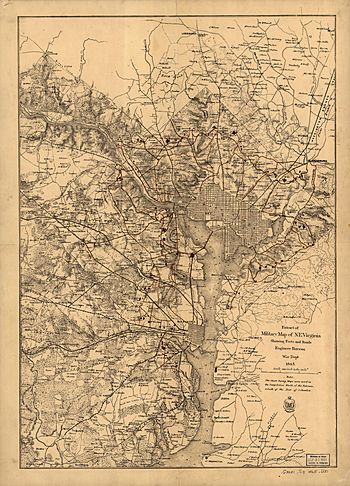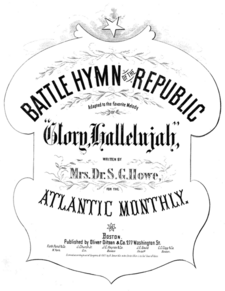Upton's Hill facts for kids
Upton's Hill is a special place in Arlington County, Virginia. It's a hill that rises about 125 meters (410 feet) above sea level. Imagine standing on top and seeing far and wide!
Contents
Where is Upton's Hill?
Upton's Hill is right on the edge of Arlington County, Virginia and Fairfax County, Virginia. It's shaped a bit like a cone. The very top of the hill is where Wilson Boulevard and McKinley Street meet. You'll see a big water tower there today, which helps mark the summit.
Close by, you can find one of the original boundary stones that marked the edge of the first District of Columbia. It's about 30 meters (100 feet) southeast of the water tower.
A stream called Four Mile Run flows along the north and east sides of the hill. Other hills nearby include Munson's Hill to the southeast and Minor's Hill to the northwest. From Upton's Hill, you can look out over Arlington County and even the city of Washington, D.C..
How Upton's Hill Got Its Name
Sometimes people just call it Upton Hill. During the American Civil War, you might have seen its name spelled in different ways in old newspapers and letters from soldiers.
The hill is named after a man named Charles H. Upton. He was a newspaper editor from Ohio who moved to this area in 1836. Charles Upton kept working on newspapers from his home in Virginia for more than 30 years.
By the time the Civil War started in 1861, Charles Upton had built a beautiful home on top of the hill. It was located where Wilson Boulevard and McKinley Street are today. His home was surrounded by fruit trees and was part of a working farm. The large house there now is not the original one, but it's in the same spot.
Today, there's a park called Upton Hill Regional Park nearby. It's part of Northern Virginia Regional Park Authority and is named after the hill, keeping its name alive.
History of Upton's Hill
Ancient Times and Early Settlers
Long before Europeans arrived, Native American people in Northern Virginia knew Upton's Hill well. Four Mile Run was an important water source for them. Upstream from the hill, in Falls Church, there were places where they carved soapstone, showing how popular the stream was. The valley of Four Mile Run, at the base of Upton's Hill, was also a good path for travel from the Potomac River.
English colonists started the town of Falls Church in 1733. They chose a spot about a day's horseback ride from the Potomac River. For many years, people living on Upton's Hill were connected to Falls Church because it had the closest post office and stores.
After America Became a Country
After the American Revolution, the area grew quickly. More people moved into Virginia's inner and mountain areas. To help with trade, the Alexandria, Loudoun & Hampshire Railroad was started. This railroad connected the port of Alexandria with Leesburg and was planned to go all the way to what is now West Virginia.
The railroad opened in 1860. Its path followed the valley of Four Mile Run, winding around the base of Upton's Hill. The closest train stops were at Carlinville, east of the hill, and Falls Church, to its west.
The Civil War Years
The American Civil War officially began in 1861, but on Upton's Hill, problems started earlier, in 1859. This was after an event involving John Brown at Harper's Ferry. This made people in the area think deeply about slavery and how much power states should have. Many people from the North lived in Falls Church and on Upton's Hill, including Charles Upton. Their neighbors from the South began to make them feel unwelcome.
Virginia held a vote to decide if it would leave the Union. In Falls Church, the vote to leave was very close: 44 for leaving and 26 against. Each person's vote was announced out loud. Some Northerners felt unsafe because armed Southerners, including some new Confederate army officers, were present.
Hugh W. Throckmorton, Charles Upton's son-in-law, also lived on Upton's Hill. He voted for Virginia to stay in the Union. Hugh said his brother, John A. Throckmorton, led a group of Southerners who made Northern voters feel scared at other voting places. One night, one of John's men came to Upton's home looking for Hugh. Hugh hid in a cornfield and left at dawn, not stopping until he reached the safety of Washington. It's believed he and John never spoke again.
During that same election on May 23, 1861, Charles Upton ran for the United States Congress. He won and became a member of the House of Representatives. However, a few days later, his position was questioned because Virginia had left the Union. How could he represent Virginia if it was no longer part of the Union?
The House of Representatives decided he couldn't. Upton served until February 1862. After that, President Abraham Lincoln appointed him as a United States consul to Switzerland. He served in Switzerland from 1863 until he passed away in Geneva in 1877.
The Union Army's big loss at the First Battle of Manassas in July 1861 changed everything on Upton's Hill. Union troops ran back to Washington in a messy retreat. Confederate troops followed and took over Upton's Hill and nearby Munson's Hill.
Charles Upton sent his family to safety in Ohio and moved to Washington. Confederate Army troops, led by his brother-in-law John Throckmorton, took over his nice home. They took his furniture and even three enslaved people belonging to Hugh Throckmorton. Because two armies used it so much, the house was badly damaged. A soldier from Virginia wrote home, "It was a beautiful house built out of white pine and right new... [Upton] had every convenience about his house that the heart could wish, but everything is torn to pieces."
Things quickly turned in the Union's favor. Confederate troops left the hill in late September 1861 and went back to Manassas. Union troops then took over the hill and Upton's home. Upton's Hill became important during the war because the Union Army used the home as its headquarters. The fruit trees were cut down, and a large stone fort was built across the road (now Wilson Boulevard) at the very top of the hill.
This fort was first called Fort Upton, but later it was renamed Fort Ramsay. There are still some drawings, photographs, and lithographs of it. They show a strong structure with many long-range cannons and soldiers. Around the fort, on different parts of the hill, were several large Union army camps. These included Camp Bliss, Camp Dupont, Camp Graham, Camp Keyes, Camp Marion, Camp Niagara, and Camp Upton. These camps replaced earlier Confederate defenses.
By the end of the war, the Union Army built a tall wooden observation tower on top of Congressman Upton's home. From this tower, they could send signals to the Washington Monument and other signal stations. The hill was also connected to the military telegraph system. At first, it connected to an army headquarters in General Robert E. Lee's old home (now the Custis-Lee Mansion) in Arlington National Cemetery. Later, it became part of a bigger regional network.
The Battle Hymn of the Republic
A very famous song, Battle Hymn of the Republic, was written because of things that happened on Upton's Hill!
In November 1861, Julia Ward Howe rode in a carriage from Washington to Upton's Hill. She was with the governor of Massachusetts and other friends to watch a review of troops. The review was stopped because there were reports of a fight west of Falls Church. A Union army cavalry unit might have been outnumbered by a larger Confederate force. The review ended quickly, and soldiers rushed to Falls Church.
Mrs. Howe was impressed by the troop review and by the sights and sounds she saw as she left that night. The campfires and shiny weapons made a big impression on her.
As she rode back to Washington in her carriage, they went slowly because soldiers were marching in front of and behind them. The soldiers were singing a popular song called John Brown's Body ("John Brown's body lies a-mouldering in the grave…" ). A friend in the carriage suggested that Mrs. Howe, who sometimes wrote poems, should write new words for the tune. "I wish I might!," she replied.
Early the next morning, Mrs. Howe woke up in her hotel room in Washington. She felt like she was writing poetry in her mind. She "...found that the wished-for lines were arranging themselves in my brain. I lay quite still until the last verse had completed itself in my thoughts, then hastily arose, saying to myself, 'I shall lose this if I don't write it down immediately'."
The magazine Atlantic Monthly published Mrs. Howe's poem, set to the tune "John Brown's Body," in February 1862. They called it "Battle Hymn of the Republic." It was an instant hit and was very popular in the North for the rest of the war, and it's still famous today.
People who were there said that "Battle Hymn" was written because of the troop review on Upton's Hill. Later, some historians got confused and thought the song was born at a much larger review held by President Abraham Lincoln at Bailey's Crossroads. However, it's possible that Mrs. Howe and others were actually watching the Bailey's Crossroads review from Upton's Hill.
Upton's Hill Today
Today, the top of Upton's Hill has a large water tower and an apartment complex. This shows how much the hill changed with new homes and businesses in the 1950s and 1960s. Some parts of the hill are still natural woods, thanks to the Upton Hill Regional Park. This park also has a pool, a water park, and batting cages. You can even see a replica of a "Quaker gun" in the park. This was a fake cannon, usually a log painted black, used to trick enemies into thinking a fort had more weapons than it did. The slopes of the hill are covered with many family homes. Seven Corners, a well-known shopping area, is on a nearby hill to the south.
Images for kids




